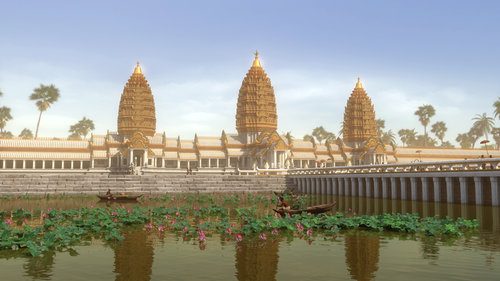
Virtual Angkor is the result of the collaboration between Archaeologists, Historians, and Virtual History Specialists, likely in the spirit of scholarly collaboration under the wings of SensiLab at Monash University in Australia. Targeted towards educators, it was created to unfurl the Cambodian metropolis of Angkor before the eyes of students, it’s a three-dimensional world that uses simulations to educate students on Angkor’s trade and diplomacy, climate, and power structures.
Presentation
Virtual Angkor is an online simulation of an average twenty-four hour day in ancient Angkor, with 360 degree educational modules (videos) constructed from pieces of that twenty-four hour day.
The concentration on the development of such a humongous simulation and its focus on authenticity and realism, suggests that the creators were focused on attempting to truly draw in students to the lessons.
The website for Virtual Angkor seems to have a similar purpose to that of the simulation itself. That is despite having a plethora of information on the creation of Virtual Angkor, the creators still focus on students and educators, including various site pages on the different themes that the simulation is supposed to teach with an explanation.
Processes
The underlying three-dimensional design of the project allows the creators to create three 360 degree panorama videos from any place, allowing one the feel like they’re actually in the position looking around. You can view some of these videos here.
In addition to the living panoramas, there is also the capability to take videos of scenes within the simulation, such as flyovers of certain parts or the entire city at certain times of day, or daily things such as construction and convoys. You can view available scenes here.
The creators have developed modules around some of the videos and photos they’ve taken within the simulation. In conjunction with the videos/photos there are additional readings in each module. The reading and Imagery combined are what make up the educational modules of Virtual Angkor
Sources
In their monumental development of Virtual Angkor, the creators utilized a variety of assets. Including a generous selection of print sources listed below:
Zhou Daguan, A Record of Cambodia, The Land and Its People, trans. Peter Harris (Chiang Mai, Thailand: Silkworm Books, 2007).
George Cœdès, Angkor: An Introduction (Hong Kong: Oxford University Press, 1963)
David Chandler, A History of Cambodia, 4th Edition (Boulder, Colorado: Westview Press, 2008).
Ian William Mabbett and David Chandler, The Khmers (Silkworm Books, 1996).
Michael D. Coe, Angkor and the Khmer Civilization (London: Thames & Hudson, 2003).
John Burgess, A Woman of Angkor (New York: River Books, 2013).
Their cited online/virtual sources, among which are listed scholarly articles and websites are similarly cited below.
University of Sydney’s Angkor Research Program.
Temples of Angkor via Google Maps Street View.
Damian Evans, Christophe Pottier, Roland Fletcher, Scott Hensley, Ian Tapley, Anthony Milne and Michael Barbetti, “A comprehensive archaeological map of the world’s largest preindustrial settlement complex at Angkor, Cambodia,” Proceedings of the National Academy of the Sciences of the United States of America 104, no. 36 (2007): 14227-14282. https://doi.org/10.1073/pnas.0702525104
Brendan M. Buckley, Kevin J. Anchukaitis, Daniel Penny, Roland Fletcher, Edward R. Cook, Masaki Sano, Le Canh Nam, Aroonrut Wichienkeeo, Ton That Minh and Truong Mai Hong, “Climate as a contributing factor in the demise of Angkor, Cambodia,” Proceedings of the National Academy of the Sciences of the United States of America 107, no. 15 (2010): 6748-6752. https://doi.org/10.1073/pnas.0910827107
Roland Fletcher, Damian Evans, Christophe Pottier, Chhay Rachna, “Angkor Wat: An Introduction,” Antiquity 89, no. 348 (2015): 1388-1401. https://doi.org/10.15184/aqy.2015.178
Additionally, the project had support from faculty at Flinders University and the University of Texas at Austin
By all evidence, it is evident that the creators attempted to create the most accurate representation of Angkor that they could. In doing so they have done great service in educating populations on 13th century Angkor.